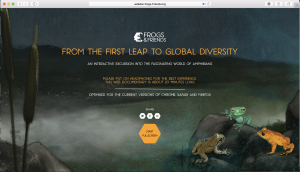Having spent some time exploring Database Narrative, particularly Rhizome Narrative I have been thinking more and more about the kind of project I would like to propose. I have had a concept called Cultureline created in a previous semester in a proposed series of podcasts and also a digital tour of India as part of that…but how can I change things up and create a project which aligns with my goals? A part of my dream career pathway would be to work closely with exhibitions and museums and I absolutely love the idea of creating a project that is both enlightening, sharing something new or less known and in a format that is extremely engaging and immersive.
I found myself extremely inspired by the Frogs and Friends virtual excursion I came across as part of my first assessment:
If I could create material that was intriguing or thought-provoking then my job is done and well and truly cut out. But how? I could use the plan concepts from the podcasts I set out to create and create parcels of information around each topic from History to Food, Music etc. I could possibly expand upon it by including all the mixed cultures I intend to cover the platform of the Cultureline concept, but that would mean a much bigger project and more resources. If I began with Anglo-Indians, I would have most of my resources readily available because I am a member of that community and know many people who would be happy and proud to be involved in such a piece. I would be inclined to make contact with people in Australia, India, the UK etc.
Cultureline: An Odyssey of Anglo-India
Create a “Who am I?” question around either an everyday occupation that the Anglo-Indians have been renowned for (for example the locomotive industry) to engage the audience which would then take you to a main page with three sections “Silk Road” ,”Imperial Route” and “A Global Minority’s Journey” that takes the audience through three different pathways in the history or background of Anglo-Indian roots, traditions, psyches etc….
I think it would be an interesting idea to create a podcast out of this version of immersion and storytelling (as opposed to the podcast series) which could be used as a tool potentially for a real-life exhibition and carnival, using bites of information, scanner codes with a real-life sense of database narrative style approach. It could be hosted on Anglo-Indians Day on August 2nd. Just some ideas …
—————————————————————————————————–
Edit 09/05/2018: A little late here, but as it turns out, the Frogs & Friends captured the hearts of some of my fellow students after our presentation!
I really appreciated the feedback in the blog by Chandler Ding (2018, para.1), ‘Melissa shown substantial evidence in the storytelling of database narrative and clearly decomposed the characteristics in the theory of Deleuze and Guatarri. By the way, she found an excellent example of Frogs & Friends, which made us very interested in an audience, and they answered most of the questions and timely feedback.’
Interestingly, some critique for the colour chosen for our presentation by JoyAnn Wong (2018, para 2), ‘ One thing I think they can do better is that the color of the power point is too dark so it has been difficult to watch.’ I truly wish I’d read this before I pitched my idea and gave my branding a bit more strength.
Reference:
Frogs & Friends 2015, Frogs & Friends VR, Viewed 25 March 2018, http://www.frogs-friends.org/en/
Chandler Ding, 19/04/2018, Week 4- Database Narrative, viewed 09/05/2018
Joyann Wong, 08/05/2018, Database Narrative NDIN Blog: Week 4, viewed 09/05/2018


